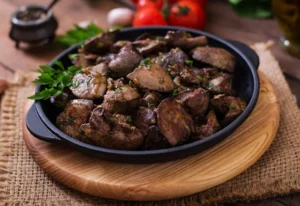
营养素是我们健康的关键,对骨骼生长和高能量尤为重要。虽然我们每个人都需要相同的营养素,但每个人所需的营养素数量因年龄、生长和活动而异。营养素一般可分为两类:宏量营养素(蛋白质、脂肪和碳水化合物)和微量营养素(维生素、矿物质和辅助因子)。由于宏量营养素和微量营养素在人体内都具有重要功能,因此要确保摄入正确平衡的营养素,以获得最佳的健康和福祉。儿童尤其需要在饮食中摄入适当的营养素,以帮助他们满足因体力活动、生长发育和学习而增加的需求。
以下是我们为您推荐的 6 大营养素,它们能让您的孩子在各个成长阶段都保持健康:
1.蛋白质
蛋白质是构成人体每个细胞的主要成分,是生命所必需的。蛋白质可以帮助孩子的身体将食物分解成能量、抵抗感染并在血液中携带氧气。有 20 种单体 "基础 "氨基酸,我们从中合成蛋白质,帮助身体生长和修复。其中 9 种被认为是 "必需 "的,因为我们的身体无法制造它们。动物蛋白质被认为是完整的蛋白质来源,因为它含有所有必需氨基酸和条件必需氨基酸,还含有生物利用率高的维生素和矿物质。内脏和贝类尤其富含必需营养素。尽早开始食用内脏肉类,让他们尝尝鲜。在许多文化中,肝脏是婴儿开始吃固体食物时的 "第一道食物"。需要注意的是,你需要把脂肪和肉一起吃掉,所以不要修剪脂肪,更不要听信 "吃瘦肉 "的鬼话。
至于植物性食品,很少含有全部 9 种必需氨基酸,有些氨基酸含量不足,如蛋氨酸和半胱氨酸。许多植物蛋白食品都经过高度加工,添加了油脂和调味料,植物蛋白缺少动物蛋白所含的大部分营养素和辅助因子。此外,植物蛋白的生物利用率低于动物性食品,因此您可以将大米和豆类结合起来以增加必需氨基酸的含量,但它们的生物利用率只有动物性食品的一半,因此您必须摄入至少两倍的热量。
此外,植物性食物中含有许多防御化学物质,会抑制营养物质的消化/吸收。豆腐和豆豉含有高蛋白,但只应偶尔使用或作为调味品,在亚洲就是如此。世界上少数真正的素食文化在养育孩子时不吃肉和鱼,他们的孩子会遇到更多的健康问题,甚至发育迟缓和大脑发育问题。肉碱、肌酸、牛磺酸、甘氨酸和肌肽等蛋白质是由我们的身体制造的,但往往达不到我们所需的水平,因此从食物中获取这些蛋白质也很重要。这些蛋白质对于健康的大脑功能、新陈代谢、肌肉、消化等都是必不可少的,而任何植物性食物中都不含有这些蛋白质。研究表明,建议将动物性食物作为儿童饮食的基础,主要是因为动物性食物富含可生物利用的营养素,而这些营养素在植物性食物中缺乏或含量较低。食用米饭和豆类等食物的文化通常也会在菜肴中添加肉类和/或骨头汤。
- 红肉
- 家禽
- 鱼类
- 鸡蛋
- 内脏肉类--肝脏、肾脏、心脏等
- 全脂牛奶和奶酪
- 米饭和豆类(通常还有动物蛋白)

2.脂肪
脂肪和胆固醇是生命的必需品,存在于每个细胞膜中。它们在支持皮肤健康、保湿和修复方面发挥着重要作用;有助于免疫反应;是一种燃料来源,尤其是在睡眠期间。胆固醇是类固醇激素和维生素 D 的基本分子。虽然我们可以在体内合成脂肪和胆固醇,但要让身体吸收脂溶性维生素 D、E、K 和 A,就必须在饮食中摄入脂肪,此外,我们每天只能制造约 80% 的胆固醇。研究表明,低脂饮食的儿童成年后更容易肥胖。
人体不能制造欧米伽-3 和-6 脂肪酸,因此我们必须从饮食中获取它们。健康的动物脂肪,包括红肉,尤其是鱼类,含有人体必需的欧米伽-3 脂肪酸 DHA 和 EPA,对大脑的健康、发育和成长至关重要。植物油经过高度精炼,omega-6 和 omega-3 的比例过高。坚果和种子中含有可利用的欧米伽-3--DHA 和 EPA 的前体--α-亚麻酸,但不幸的是,我们大多数人向 EPA,尤其是 DHA 的转化受到了限制。这就是为什么儿童必须摄入动物脂肪,以及为什么传统文化将动物食品作为青少年的优先食物。
- 动物脂肪 - 肥肉,包括鱼类
- 乳脂 - 黄油、酥油、全脂酸奶、奶酪
- 蛋黄
- 牛油果
- 橄榄油
- 椰子油
- 一些坚果和种子(最好经过浸泡和 "激活")。
3.碳水化合物
葡萄糖形式的碳水化合物被认为是人体能量的主要来源--葡萄糖是大脑良好运转的必要条件,而人体中的某些细胞,如红细胞,只能利用葡萄糖作为能量。人体制造葡萄糖的能力很强,但最好还是尽可能从饮食中获取人体所需的所有物质。不过,儿童确实需要在饮食中摄入碳水化合物;否则,他们可能会出现生长问题。生酮饮食如今非常流行,但因治疗原因而接受生酮饮食的儿童会出现发育迟缓的问题。碳水化合物能支持情绪激素,帮助儿童利用脂肪和蛋白质来构建和修复组织。碳水化合物有多种形式,包括根茎类蔬菜(如库马拉、土豆和胡萝卜)以及水果和蔬菜。全谷物并非饮食中的必需品(所有必需营养素都可以通过以动物为食的水果和块茎类食物获得),但如果通过浸泡、发芽、发酵和烹饪等方法进行适当烹调,则可以使用全谷物。最重要的一点是,除了白米饭和传统面食等传统精制碳水化合物食品外,要限制或避免食用高度加工食品和碳水化合物。
- 南瓜
- 库马拉
- 马铃薯
- 胡萝卜
- 水果
- 蔬菜
- 大米
- 浸泡/发酵粥
4.钙

钙对强健骨骼和健康牙齿至关重要。但您知道吗,钙对能量产生、免疫系统调节、神经和心脏功能也很重要。同样,钙的最佳来源是动物性食物,因为植物性食物中含有的化合物会抑制钙和其他矿物质的吸收。种子中的钙的生物利用率可以通过传统的植物性食物制作方法(浸泡/活化)来提高,但不应该依靠这些方法来满足儿童对钙的大部分需求。尽可能少选择经过加工的奶制品......除非孩子对奶制品过敏,或者在文化上不适合。
- 未经加工的动物奶
- 奶酪和/或奶油奶酪
- 酸奶和/或酸乳酒
- 带骨三文鱼罐头
- 骨粉
- 灭菌蛋壳粉(功能性食品补充剂)
- 活性芝麻
5.铁
铁是健康血液所必需的,它能帮助细胞发挥正常功能,并将氧气带入全身细胞,从而提高能量水平。铁也是健康的大脑功能和情绪所必需的。铁有两种形式:血铁和非血铁。血红素铁来自动物性食物,尤其是内脏--肝脏是最丰富的来源,因此应优先选择动物性食物。非血红素铁来自植物,吸收率低,需要在进餐时补充维生素 C。
- 风干肉
- 红肉
- 贝类
- 鱼、猪肉、家禽
- 深绿叶蔬菜(吸收率低)
6.维生素 C
维生素 C 是人体必需的营养素,无法在体内储存,必须从饮食中摄取。维生素 C 不仅对免疫健康至关重要,还能帮助人体愈合伤口,并通过强化血管壁来减少瘀伤的发生。维生素 C 有助于保持牙龈和牙齿的健康,并有助于强健骨骼的生长。
- 柑橘类水果
- 猕猴桃 - 尤其是黄金猕猴桃
- 草莓
- 黑醋栗
- 红辣椒
- 西兰花
- 风干肉
其他营养素
还有许多其他必需的维生素和矿物质--例如脂溶性维生素 A、D3、K2 和 E--对孩子牙齿、骨骼和面部结构的发育至关重要,所有这些都会影响他们成年后的健康。生长发育所必需的其他矿物质,如镁、碘(在青春期非常重要)、钾、磷、铜和锌,在动物性食物中的生物利用率更高,但也可以通过传统的植物性食物制作方法获得。这些食物的传统制作方法详见 韦斯顿-A-普莱斯基金会的 网站。如果您和您的家人专注于...
- 动物性食品及其脂肪
- 易消化的碳水化合物,如水果、块茎和蔬菜 孩子们喜欢的
- 只使用全食品
- 学习用传统方法加工和制作植物食品
- 尽量少吃或不吃垃圾食品和加工食品
......您的孩子将获得成长和学习所需的全部营养。让孩子们了解营养的重要性,有助于他们养成良好的生活习惯。
